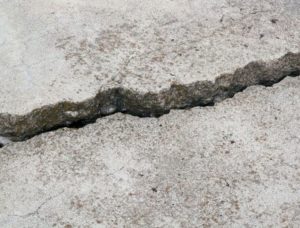Concrete Slab Repair By Slab Jacking To Fix Concrete Slab Settlement.

Every household will have to face soil settlement in the future. So it’s not a matter of prevention, but rather preparation. Though there are means to mitigate the adverse effects of settlement, we simply can’t prevent settlement completely. We can only prolong it, this can be done with concrete slab repair.
Fortunately, there are means to accurately predict the settlement timeline by basing on the type of soil that your house is sitting in. Soil composition alone can offer us a great deal of insight with regards to the timeline of settlement and how deep would be the potential settlement is.
It’s common knowledge nowadays that clayey soils settle the most whereas sandy soils settle the least. As such, it’s for your best interests as a homeowner to know the type of soil your house is sitting in. Doing so can give you ample time to prepare for what types of repairs you’ll be needing if need be.
What is Concrete Slab Settlement ?
Concrete slab settlement is an event when the soil beneath it settles significantly that it leaves a void portion between it and the soil. After which, the slab doesn’t have contact with the soil, thereby leaving the slab in a suspended state where it can be bent or twisted due to stresses which can cause cracks.
These type of cracks are a major concern for water leakage and the total separation of the slab from the house. So as the onset of slab settlement signs start to appear, deal with it immediately.
On the next section, we’ll be sharing with you our concrete slab settlement repair guide by slab jacking. This methodology guarantees an effective permanent repair, especially for front yard concrete driveways.
How To Perform Concrete Slab Repair Slab Jacking.
Slab jacking is a methodology used for replacing material that settled under the slab and raising it to the appropriate elevation. We use a strong cement-based material to fill in voids between the slab and soil.
Step 1: Mark the delimitation area of the settle slab.
Usually, the cracked portion is the main section where the slab settled. In order to fill out the most voids beneath the slab and raise its elevation, you’ll need to increase the delimitation area using level lasers and string lines.
Step 2: Drill holes through the concrete.
The number of holes is dependent on how much area is going to be raised. The larger the area, the more numerous the holes will be. There are two purposes for the holes: one is for raising the slab and he second is for filling in voids.
Step 3: Pump highly-viscous cement-based material
This highly-viscous material provides the most lift capacity and spreads out minimally. Thereby allowing you to get a controlled lift from various points within the delimitation area until the slab is lifted back to its original position. Setup level lasers and string lines around the area to know if the right elevation is reached.
Step 4: Pump low-viscous cement-based material.
The low-viscous material serves as the filling material to the remaining voids. It also pressurizes the area, making it more durable against outside forces.
Step 5: Patch all holes with structural mortar.
Step 6: Cure and avoid foot traffic for 1 day.
Contact Us For More!
Affordable Structural Builders has been in the structural repair business for many years now — providing all levels of service from crack repair to concrete retrofitting. One service that we provide is high-pressure grout injection used to lift settled concrete slabs. If you have further questions regarding our other services or more of the same, don’t hesitate to give us a call.
